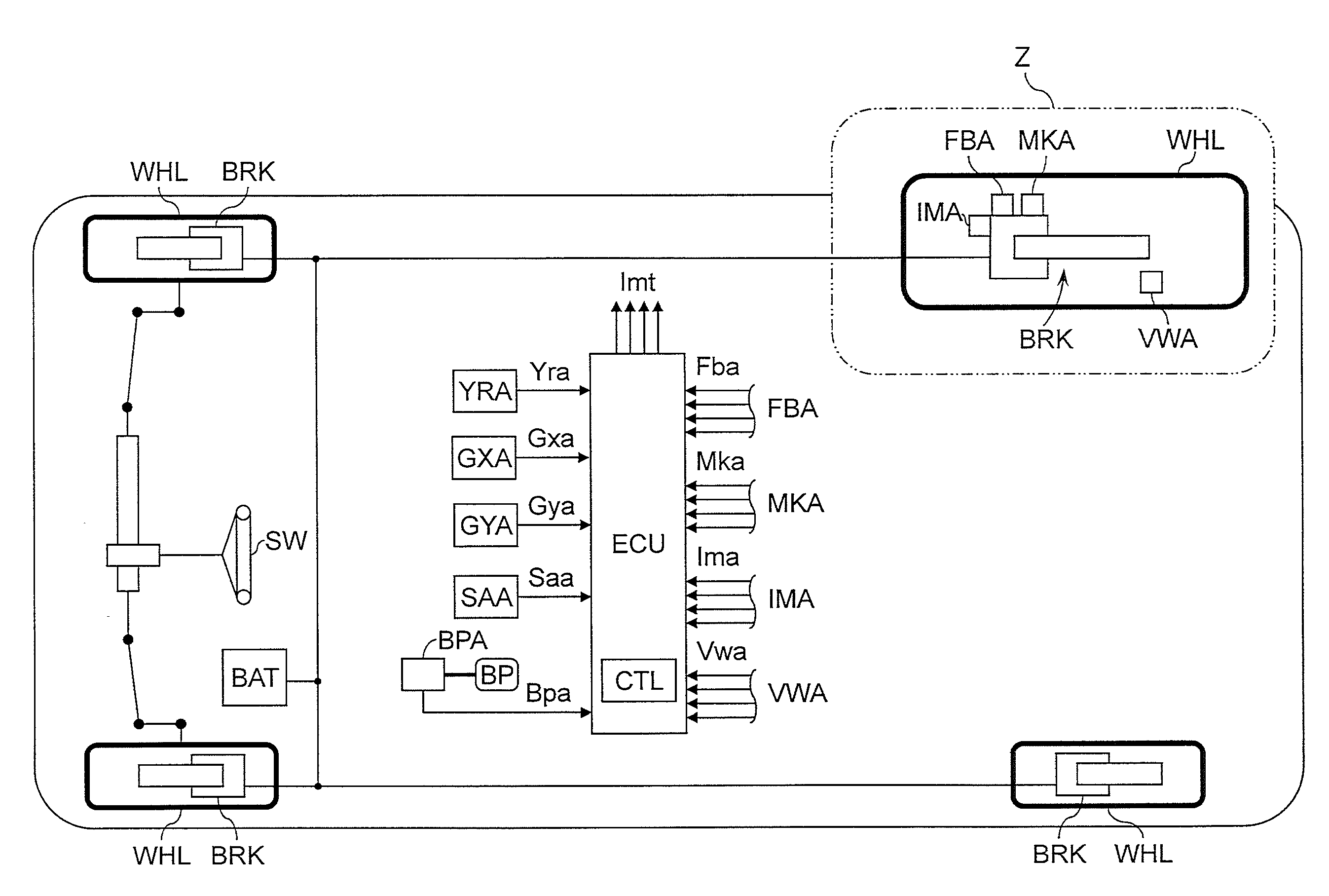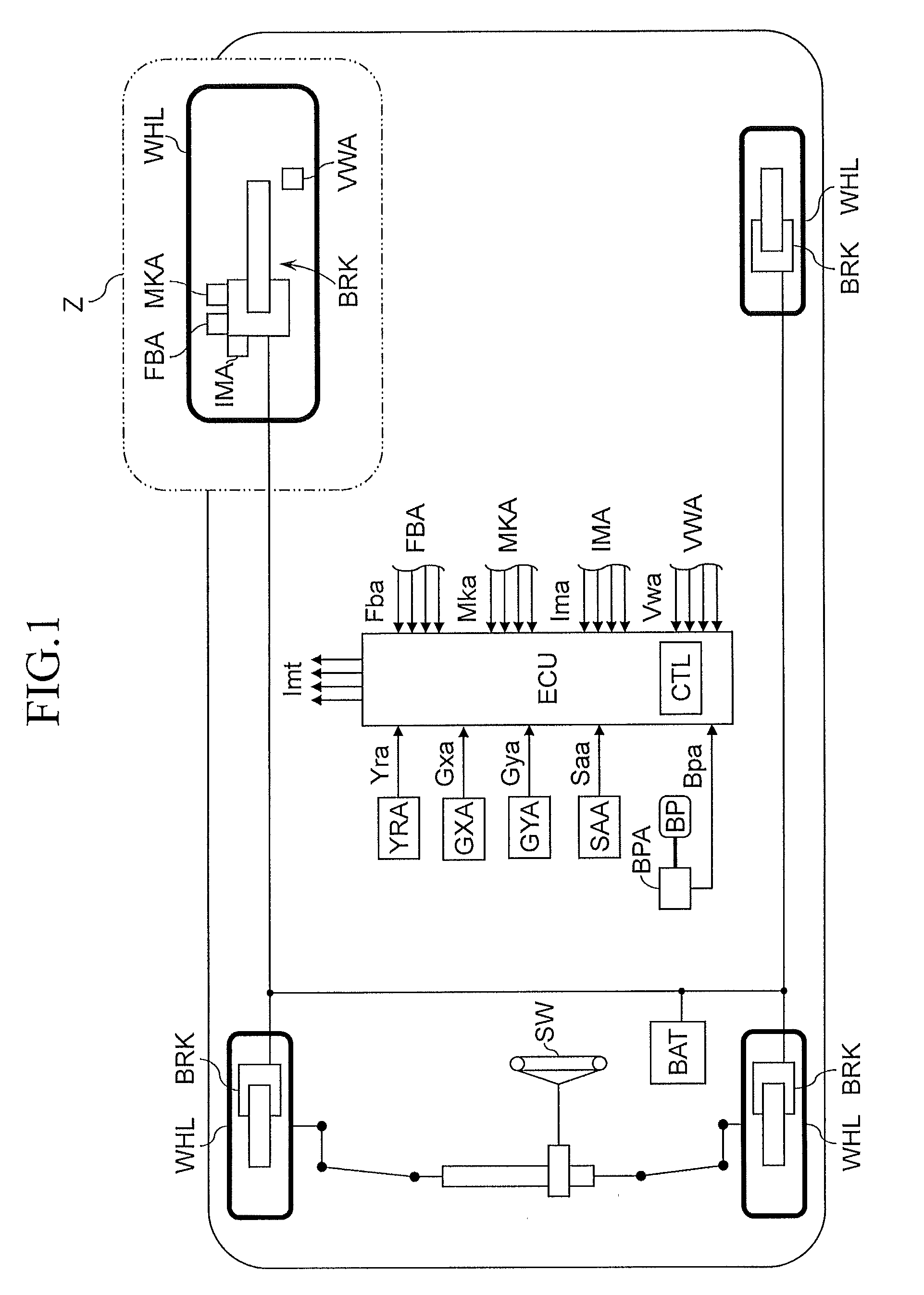Braking control device for vehicle
a technology of brake control and brake actuator, which is applied in the direction of braking systems, instruments, analogue processes for specific applications, etc., can solve the problems of difficulty in ensuring the accuracy of the braking torque on the wheel in terms of the relationship with and the braking torque is gently decreased, so as to reduce the amount of output torque due to the torque ripple of the electric motor and increase the effect of the output torqu
- Summary
- Abstract
- Description
- Claims
- Application Information
AI Technical Summary
Benefits of technology
Problems solved by technology
Method used
Image
Examples
first embodiment
[0069]FIG. 5 is a functional block diagram illustrating the torque ripple compensation feedback control block TRB according to the present invention. The TRB includes a target-position calculation block MKT, a deviation calculation block, and a torque ripple compensation feedback energization amount calculation block IBT.
[0070]In the MKT, a target position (for example, a target rotation angle) Mkt of the electric motor MTR is calculated based on the target pressing force Fbt and a calculation characteristic (calculation map) CHmk. In the deviation calculation block, the actual position (for example, the rotation angle) Mka of the electric motor is subtracted from the Mkt to calculate a deviation ΔMk (=Mkt−Mka) between the target value and the actual value.
[0071]In the IBT, the feedback energization amount Ibt for compensating for the torque ripple is calculated based on the deviation (positional deviation) ΔMk at the position of the MTR and a calculation characteristic (calculation...
second embodiment
[0078]FIG. 6 is a functional block diagram illustrating the torque ripple compensation feedback control block TRB according to the present invention. The TRB includes the torque ripple compensation feedback energization amount calculation block IBT. The feedback energization amount Ibt for compensating for the torque ripple is calculated based on the pressing-force deviation ΔFb. The feedback energization amount Ibt is calculated based on the pressing-force deviation ΔFb which is calculated by subtracting the actual pressing force Fba from the target pressing force Fbt and a calculation characteristic (calculation map) CHc.
[0079]On the characteristic CHc, when the ΔFb is smaller than a third predetermined deviation (predetermined value) fb3 (0), the Ibt is calculated so as to monotonically increase from the ib1 through the origin O to the ib2 as the ΔFb increases. When the ΔFb is equal to or larger than the fourth predetermined deviation (predetermined value) fb4, the second predete...
third embodiment
[0091]Similarly to the TRB of each of the embodiments described above, also in the TRB of the third embodiment, on the calculation map CHd, in the region corresponding to the torque ripple (in the range where the ΔFb is from fb3 to fb4), the control gain (inclination of (Ipt+Ibt) with respect to the ΔFb) Kpd2 is set to a relatively large value. Therefore, the feedback control for instantaneously reducing the deviation to zero can be executed. Moreover, outside of the torque ripple region, the control gain Kpd1 is set to a relatively small value with which the control gain is used for normal feedback control. As a result, the stability of the control system can be ensured. By setting the control gain indicated on the calculation map CHd, the stability of the whole BRK can be ensured, and the feedback control can follow even a slight deviation to appropriately compensate for the effects of the torque ripple.
[0092]Similarly, the pressing-force feedback control block IPT (see FIG. 7) an...
PUM
 Login to View More
Login to View More Abstract
Description
Claims
Application Information
 Login to View More
Login to View More - R&D
- Intellectual Property
- Life Sciences
- Materials
- Tech Scout
- Unparalleled Data Quality
- Higher Quality Content
- 60% Fewer Hallucinations
Browse by: Latest US Patents, China's latest patents, Technical Efficacy Thesaurus, Application Domain, Technology Topic, Popular Technical Reports.
© 2025 PatSnap. All rights reserved.Legal|Privacy policy|Modern Slavery Act Transparency Statement|Sitemap|About US| Contact US: help@patsnap.com



